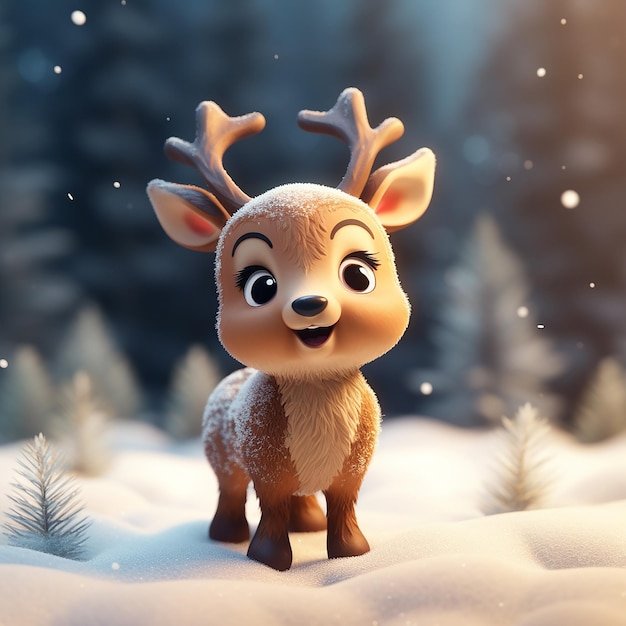
Think of reindeer as the ultimate survivors of the Arctic. They’ve developed methods to thrive in their icy homes, making them some of the most fascinating animals to study. So, grab a warm cup of coffee, and let’s dive into the world of reindeer intelligence—how they think, act, and interact with their surroundings.
Reindeer: An Overview of Their Habitat and Behavior
Before we get into their intelligence, it’s helpful to understand where reindeer live and how they behave. Reindeer, also known as caribou, are native to the Arctic tundra and boreal forests. These areas are characterized by cold temperatures and long winters, which means reindeer have adapted in unique ways.
What’s interesting is their migratory behavior. Reindeer travel in herds, often covering hundreds of miles in search of food. This instinctual behavior isn’t just about finding food; it’s also a strategic move. By moving together, reindeer can protect each other from predators and navigate their environment more effectively. It’s a great example of animal teamwork at play.
In these harsh climates, reindeer rely heavily on their senses. Their large, mobile nostrils help them detect food hidden beneath the snow. They can even use their sense of smell to locate lichen, a key part of their diet. This adaptability speaks volumes about their ability to thrive even in the toughest conditions.
Understanding Reindeer Cognitive Abilities
Cognitive abilities in animals refer to their mental capabilities—how they perceive, process, and respond to information. Reindeer showcase some impressive skills that suggest they are quite intelligent. For starters, reindeer possess excellent memory. They can remember routes to food sources and grazing areas, which is essential for survival.
Here’s the thing: their memory isn’t just about the physical routes they’ll take. It also involves social memory. Reindeer can recognize other members of their herd, which helps maintain group structure and cohesion. This social awareness contributes to their ability to work together during migrations and when evading predators.
Moreover, reindeer display problem-solving skills. Think about a puzzle. If a reindeer encounters a barrier, it might look for an alternate route or use its natural instincts to dig through snow. Observations have shown that reindeer can adapt their behavior based on previous experiences, which indicates a level of learning and adaptability.
Social Structures and Communication
Reindeer are social animals that form herds, which can range from just a few individuals to thousands during migration. Their social structure is a fascinating aspect of their intelligence. These herds aren’t just random groupings; they often consist of familial bonds and complex relationships.
Communication among reindeer is essential for maintaining the herd’s dynamics. They use a variety of vocalizations, body language, and even scent marking to convey messages. Whether it’s warning others about predators or signaling readiness to mate, this communication reveals their social intelligence.
You might be wondering how communication helps with survival. In a group, reindeer can be vigilant against threats, using their combined senses to detect danger early. This kind of teamwork is critical in the wild, where every moment can mean the difference between life and death.
Problem Solving and Tool Use
While reindeer are not known for using tools in the way some primates do, they exhibit problem-solving abilities that show a form of intelligence. For example, in winter, when the ground is covered in snow, reindeer will dig through the snow to find food. They know the best techniques to access lichen and other edible vegetation, demonstrating their ability to think critically about their needs.
What’s more, they’ve been observed using their antlers to scrape away snow. While this isn’t tool use in the traditional sense, it highlights their resourcefulness. Let’s think about it: if you were hungry and faced a barrier, wouldn’t you try different methods to access your food?
This adaptability is crucial for their survival. As climate changes affect food availability, reindeer must be able to adjust their foraging techniques to cope with new challenges.
Adaptations to Harsh Environments
Reindeer have developed remarkable adaptations that not only contribute to their survival but also point to their intelligence. One of their most notable features is their specialized fur, which insulates them against extreme cold. The unique structure of their hair traps air, providing warmth without adding too much weight.
Additionally, reindeer have a unique way of coping with snow. They have a special layer of fat under their skin. This insulation helps them retain heat during frigid temperatures, allowing them to conserve energy while searching for food.
You might be surprised to learn that reindeer can also lower their body temperature slightly in extreme cold. This ability reduces the risk of freezing and allows them to remain more agile. It’s like putting on an extra layer without the bulk—it’s all about making smart choices in tough circumstances.
The Connection Between Intelligence and Survival
The cognitive abilities of reindeer are deeply tied to their survival. As we’ve seen, their intelligence helps them remember migration routes, adapt to food scarcity, and communicate effectively within their herds. This connection between smart behavior and survival is a crucial theme in the animal kingdom.
For reindeer, being smart means making better decisions, whether it’s avoiding predators or finding the best foraging spots. Their social structures and learned behaviors enhance their chances of survival, especially in fluctuating environments.
This adaptability isn’t just fascinating; it serves as a reminder of how interconnected intelligence and survival are in the natural world. The clever strategies employed by reindeer highlight their evolutionary success and the importance of cognitive skills in the animal kingdom.
Reindeer might not be the first animals that spring to mind when you think about intelligence, but their cognitive abilities and behaviors tell a different story. From their complex social structures to their problem-solving skills and adaptations, they display a level of intelligence that is both impressive and essential for their survival.
Understanding how smart reindeer are enhances our appreciation for them as a species. They’ve adapted to thrive in some of the harshest conditions on Earth, all while showcasing remarkable mental capabilities. So, the next time you think about reindeer, remember that they are not just beautiful creatures dashing through the snow—they are smart, resourceful, and truly remarkable in their own right.

